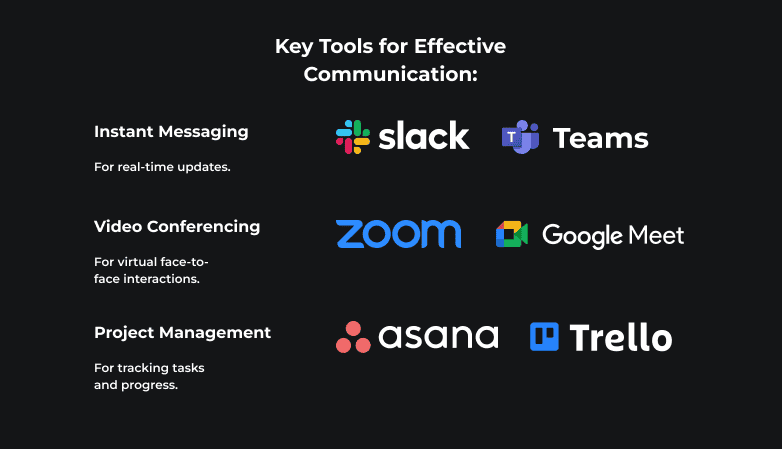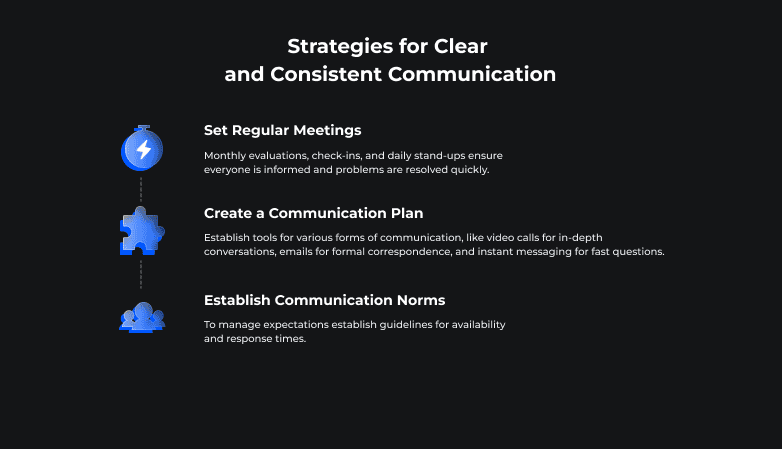Six Key Factors for Successfully Managing Distributed Teams in Software Development

LinkLinkAs of 2023, 93% of employers will continue conducting job interviews remotely. In addition, 16% of all companies have fully switched to a remote mode of work. This switch, which took place several years ago, posed critical challenges to all distributed team managers. Making everything work properly takes time and experience, but a clear roadmap is a bonus. This is why we’ve written this article to help those who still face challenges.
Factor 1: Clear Communication Channels
Effective communication is probably the most important aspect of distributed team management. Maintaining clear and consistent communication may be difficult since team members are spread across different countries. Still, managers must do it to ensure alignment with project goals and responsibilities.
Importance of Robust Communication Tools
Not seeing other people face-to-face often leads to miscommunication. One study shows that almost 53% of remote employees say it’s harder to feel connected to their coworkers, considering the lack of in-person communication.
Key Tools for Effective Communication:
- Instant Messaging: Slack, Microsoft Teams for real-time updates.
- Video Conferencing: Zoom, Google Meet for virtual face-to-face interactions.
- Project Management: Asana, Trello for tracking tasks and progress.

Strategies for Clear and Consistent Communication
- Set Regular Meetings. Monthly evaluations, check-ins, and daily stand-ups ensure everyone is informed and problems are resolved quickly.
- Create a Communication Plan. Establish tools for various forms of communication, like video calls for in-depth conversations, emails for formal correspondence, and instant messaging for fast questions.
- Establish Communication Norms. To manage expectations establish guidelines for availability and response times.

Best Practices for Virtual Meetings
- Make sure everyone knows what will be discussed by creating an agenda.
- Meetings should be brief and targeted. Allocate 30 to 45 minutes for meetings.
- Promote Involvement: Ask every participant for their thoughts.
- Subsequent Summaries: Send out a summary and action items after the meeting.
The latest industry data reveals that teams that use videoconferencing tools better communicate and have more organized work, according to 73% of employees. The success of GitLab, an all-remote firm, is attributed to meticulous communication standards. Another remote-first business, Zapier, emphasizes documentation and openness and uses Slack and Trello to facilitate cross-time zone communication.
Read also: Outsourcing Software Development to London: Costs, Benefits, and Strategic Advantages
Factor 2: Defined Roles and Responsibilities
A remote team needs well-defined roles and responsibilities to avoid misunderstandings and guarantee that everyone is aware of their responsibilities. Any remote team that wants to function well needs to retain efficiency and responsibility maintained by this clarity.
If roles and duties are not clearly defined, remote teams are more likely to get disorganized since members cannot just stop by a colleague's desk for a quick conversation. According to a Harvard Business Review research, remotely located teams with well-defined roles have a 20% higher productivity rate. Defined responsibilities minimize redundancy and guarantee that all essential duties are completed without overlap.
Detailed job descriptions that specify each team member's duties, reporting relationships, and anticipated results are crucial to achieving this clarity. All team members should have access to this paperwork so that everyone is aware of their responsibilities and how they fit into the team's overall structure. It's critical to explain each new team member's responsibilities thoroughly during onboarding and to support this comprehension with visual aids like organizational charts.
It's crucial to routinely assess and modify roles as projects progress to maintain accountability in line with team objectives and any project scope or direction modifications. This continuous modification ensures that everyone is still aware of their responsibilities and how they help the team succeed.
Asana, Trello, and Jira are a few examples of project management software that can be very helpful in organizing and monitoring tasks. These tools facilitate task delegation, deadline setting, progress tracking, and accountability transparency, improving responsibility and lessening misunderstanding. Teams can develop and update documents together using collaborative platforms like Microsoft 365 or Google Workspace, guaranteeing everyone access to the most recent information.
Roles and responsibilities at Automattic, WordPress' parent business, are well-described and subject to frequent reviews. Despite having a completely dispersed workforce, this strategy has preserved productivity and cohesiveness. Similarly, the design software company InVision employs project management tools and thorough role descriptions to maintain a cohesive and productive remote team.

Factor 3: Trust and Accountability
The cornerstone of any productive team is trust. As the renowned author of "The Speed of Trust," Stephen R. Covey, put it, "Trust is the glue of life." It is the most important component of successful communication. It is the fundamental idea upon which all interactions are based." Because members of a dispersed team depend on one another to finish tasks without the instant scrutiny available in a co-located setting, trust is even more important.
Building trust requires promoting honest and open communication. Encourage team members to express their opinions, ideas, and worries openly. A sense of continuity and dependability is fostered by frequent check-ins and updates. Being open and honest about their decisions and work shows that leaders believe their staff will act similarly.
Frequent feedback loops and performance reviews are also essential. Giving constructive criticism enables team members to see their strengths and opportunities for development. This enhances the team's performance as a whole and promotes personal development. Honoring accomplishments and individual contributions encourages team members to uphold high standards and furthers the culture of accountability.
Furthermore, it's critical to establish a welcoming atmosphere where team members feel comfortable sharing mistakes and growing from them. Promote a growth mentality in which setbacks are seen as learning opportunities rather than obstacles. This strategy promotes a culture of continual development and resilience building.
Factor 4: Cultural Sensitivity and Inclusion
Working with people from different cultural backgrounds is a common aspect of managing a remote team; the success of these teams depends on adopting cultural awareness and creating an inclusive workplace. Comprehending and honoring the disparities in beliefs, traditions, and modes of communication among team members is a crucial aspect of cultural sensitivity. Regular training on cultural competency and encouraging team members to share their cultural customs and practices will help achieve this. As a result, there will be fewer misunderstandings and a stronger sense of unity in the team's collaboration.
Inclusion makes sure that everyone feels appreciated and part of the group regardless of their background. To put this into practice, set up meetings at times that consider various time zones, speak inclusively, and celebrate different festivals and events. These procedures aid in fostering a positive atmosphere where each team member feels valued and seen. One multinational corporation that prioritizes cultural sensitivity is HubSpot, which supports diversity and inclusion programs that foster a friendly work atmosphere for all team members. This method boosts production and teamwork in addition to team morale.
Factor 5: Effective Use of Technology
The efficient utilization of technology is essential for remote teams to ensure smooth collaboration and sustained output. Collaboration services like Google Workspace and Microsoft 365 allow real-time document collaboration, guaranteeing that everyone works with the most recent information, in addition to communication and project management tools. Cloud storage services, such as Dropbox and OneDrive, offer safe and convenient file storage, which makes collaboration easier.
Cybersecurity precautions are crucial; private data is protected by programs like VPNs for safe access and LastPass for password management. Automating monotonous operations with platforms like Zapier and IFTTT can save time for more strategic work. For instance, Buffer enhances team productivity by using automation to handle social media scheduling.
Performance can be further enhanced with specialized software made to meet the team's demands, such as Tableau for data visualization or Figma for design. GitHub and Salesforce show that distributed teams may function well by strategically utilizing these tools, upholding security, and increasing overall productivity.
Factor 6: Regular Feedback and Continuous Improvement
Distributed teams must prioritize continual improvement and get regular feedback to succeed. Regular, helpful feedback promotes a culture of accountability and personal growth by assisting team members in understanding their performance and opportunities for improvement. Regular check-ins and performance reviews can be made easier using technologies like Lattice or 15Five, which guarantee prompt and useful feedback.
It is vital to foster a growth mentality among team members. Establish a culture where errors are viewed as chances for learning rather than failures. This strategy encourages inventiveness and resilience, aiding the team's adaptation and development. For instance, Atlassian often conducts retrospectives with their remote teams to evaluate what worked and what may be improved, promoting continuous process and teamwork improvement.
Conclusion
We get it: managing distributed teams can be pretty challenging. You have to deal with people from various locations, backgrounds, and mindsets. However, leaders have to adapt to new ways of doing things. Employees have tried remote work, and they don’t have any intention of returning to the office (unless organizations place an ultimatum). Hopefully, this article provided you with useful information on how to manage distributed teams with minimal complications.
If you want to learn more or have a project and seek a devoted software development partner, Yojji is here to help!

Yojji successfully delivered the project within schedule. They demonstrated excellent project management via weekly sprint demos and promptly made adjustments based on the client's feedback. Their responsiveness and collaborative attitude were key elements of their work.

5.0
Yojji was an instrumental part of the client’s team, working closely with them to achieve the product’s success. The team was very collaborative and timely, and their performance was amazing. Additionally, their resources were experienced, professional, and enjoyable to work with.

5.0
Yojii is impressive both in quality of development work as well as their commitment. Strong focus on delivery, highly technical personnel, flexible approach that allows for rapid development. Strong processes that allow for solid controls.

5.0
We’re very happy with the way that Yojji works, which is why we’ve spent so much money and engaged them for such a long time. We treat them as employees in regard to responsibilities and expectations, and they haven’t disappointed us.

5.0
As a company, we find Yojji to be excellent development partners - we cannot recommend them more highly and will be very happy to continue working with them in the future.

5.0
They are really nice people with excellent technical backgrounds.

5.0
We used Agile project management methodology and were in contact with the team and project manager daily.

5.0
They all had a super positive outlook and were dedicated to getting the work completed to a high standard.

5.0
Yojji has delivered an accessible product with thorough consideration for the client's requirements. Users have commented on the platform's user-friendliness and speed. Moreover, the team is easy to communicate with and provides frequent updates. Their development and design skills are impressive.

5.0





